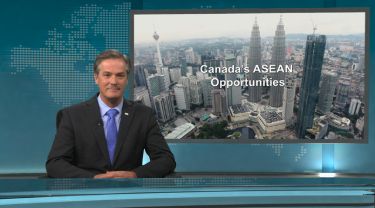Canada’s at it again: we have identified yet another chunk of the world economy with which we need a free trade agreement. The Association of Southeast Asian Nations was formed by five of its current member nations back in 1967 to promote among other things, economic growth. Today it includes original members Indonesia, Malaysia, the Philippines, Singapore and Thailand, along with Brunei, Vietnam, Laos, Myanmar and Cambodia. This alliance is often hailed a success for a number of reasons, and economic growth is certainly one of them. Its geographic location alone suggests a bright future. Is Canada benefiting?
The growth record of ASEAN economies is reason enough to deepen ties. They were collectively among the more dynamic economies entering the new millennium, and didn’t disappoint in the pre-recession years. As trading nations, they suffered during the Great Recession, and joined the stimulus bandwagon in its immediate aftermath. Recovery was impressive, thanks in part to the resilience of China’s economy. And although trade concerns are currently weighing on ASEAN members’ growth, its collective potential is still bright into and beyond the medium term.
Canada has indeed benefited from its trade with ASEAN nations. Since 2000, growth in merchandise exports to ASEAN countries has increased at more than triple Canada’s average growth to the rest of the world. In the past four years, with all its international trade difficulties, growth has remained double the pace of exports elsewhere. Total Canadian investment interests in ASEAN nations have risen by 10% annually since 2013, amounting to just over $12 billion in 2017.
Exports to ASEAN countries are fairly diversified. There’s a three-way contest for top spot between wheat, pulp and non-metallic minerals. Among top exports, food as a group accounts for a quarter of total activity, with current growth ahead of the overall average at more than 10% annually. Commodities dominate what Canada sends to ASEAN countries, but higher value-added exports like machinery and pharmaceuticals sum to more than 14% of total annual exports, and since 2000 have grown by an average of more than 10% annually.
ASEAN nations face a bright future. Indonesia, Vietnam and the Philippines often figure in lists of the ‘next’ or emerging top-potential countries on the planet. Singapore remains a regional mainstay as global trade bellwether, and Myanmar, Cambodia and Laos have huge potential for fast expansion.
Country-by-country, Canadian activities are mixed. Export growth is particularly strong to the ‘Fast-4’: Vietnam, the Philippines, Cambodia and Myanmar. Average growth is well ahead of the pack, collectively topping 15% annually in the past four years, and 9% annually since 2000. Collectively, they account for 32% of Canada-ASEAN exports. That matches our share to Indonesia alone, a dominant destination but one where performance has sagged in recent years. Likewise, recent growth of exports to Singapore, Thailand and Malaysia has been soft.
Investment is concentrated in Indonesia, the Philippines and Singapore, which together account for 88% of Canadian ASEAN holdings. Recent growth is hot in the latter two, but has flatlined in Indonesia.
Despite nascent slowing and checkered Canadian performance, regional prospects remain strong. Potential output of ASEAN nations suggests growth can remain well above the developed market average for many years to come. Book-ended by regional emerging powerhouses China and India, ASEAN economies will most likely see increasing regional demand for their resources, manufacturing output and large labour forces. And if Canada continues to grow its export and investment presence at current rates, we could see trade to ASEAN nations become a significant share of our exports—possibly zooming into our top five.
The bottom line?
In your trade diversification plans, don’t count out the dynamic ASEAN economies. As larger regional markets hit capacity constraints, ASEAN nations will increasingly be asked to fill gaps, upping their demand for Canadian goods and services. And if we do ink an FTA, prospects will be brighter still. Think about it!
This commentary is presented for informational purposes only. It’s not intended to be a comprehensive or detailed statement on any subject and no representations or warranties, express or implied, are made as to its accuracy, timeliness or completeness. Nothing in this commentary is intended to provide financial, legal, accounting or tax advice nor should it be relied upon. EDC nor the author is liable whatsoever for any loss or damage caused by, or resulting from, any use of or any inaccuracies, errors or omissions in the information provided.





